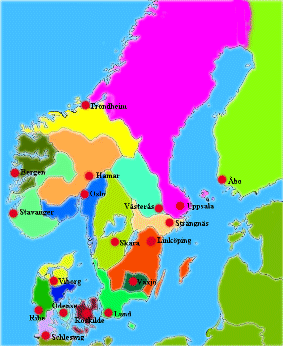Meet the Middle Ages
BackThe Organisation of the Church

Wherever people lived in Europe, they were part of the Church. The country was divided into parishes. Every parish had its own church and its own priest. The priest of the parish was responsible for the spiritual well-being of his parishioners. He also delivered sermons, heard confessions and conducted christenings and funerals. The priest was very much a part of one´s life. Sometimes the priest had assistants, lay workers, who helped him.
Together, the parishes formed a deanery with its own dean, a priest directly responsible to the Bishop. Together, the parishes and deaneries made a diocese. During the late Middle Ages there were six dioceses in Sweden; Uppsala, Linköping, Skara, Växjö, Västerås and Åbo. The Bishop was the head of the diocese - he was responsible for all the churches and the clergy within it. He ordained new priests and took the vows of monks and nuns. The Bishop was aided by the Cathedral Chapter, a church council which made important decisions. The Bishop often travelled around, visiting his churches, priests and parishioners. In many churches there would be a special chair which was reserved for the Bishop. Every country had an Arch Bishop, who was the head of all bishops.
The highest leader of the Church was the Pope in Rome. He had a number of cardinals to help him. During the Middle Ages there were10-15 cardinals.